Top Document Workflow Solutions to Boost Efficiency
Tired of Drowning in Paperwork?
Inefficient document workflows cost time and money. This listicle presents ten leading document workflow solutions to streamline your document processes, from creation and approvals to archiving. Learn how tools like Whisperit, Microsoft Power Automate, DocuSign, Nintex, SharePoint, ProcessMaker, Kissflow, Nintex K2, Zapier, and Laserfiche can improve collaboration, reduce errors, and boost productivity. Stop struggling with paper—discover the right document workflow solution for your organization.
1. Whisperit
Whisperit stands out as a leading document workflow solution, specifically designed to address the complex needs of legal professionals, healthcare providers, and compliance officers. In these document-intensive fields, efficient workflow management is crucial for productivity and success. Whisperit tackles this challenge head-on by leveraging the power of AI to streamline document creation, management, and analysis, ultimately enabling users to work up to three times faster. This translates to valuable time saved, allowing professionals to dedicate more focus to critical tasks, client interactions, and strategic decision-making. Whisperit's impressive suite of features, coupled with its robust security measures and proven ROI, makes it a worthy contender for any organization seeking to optimize their document workflow.
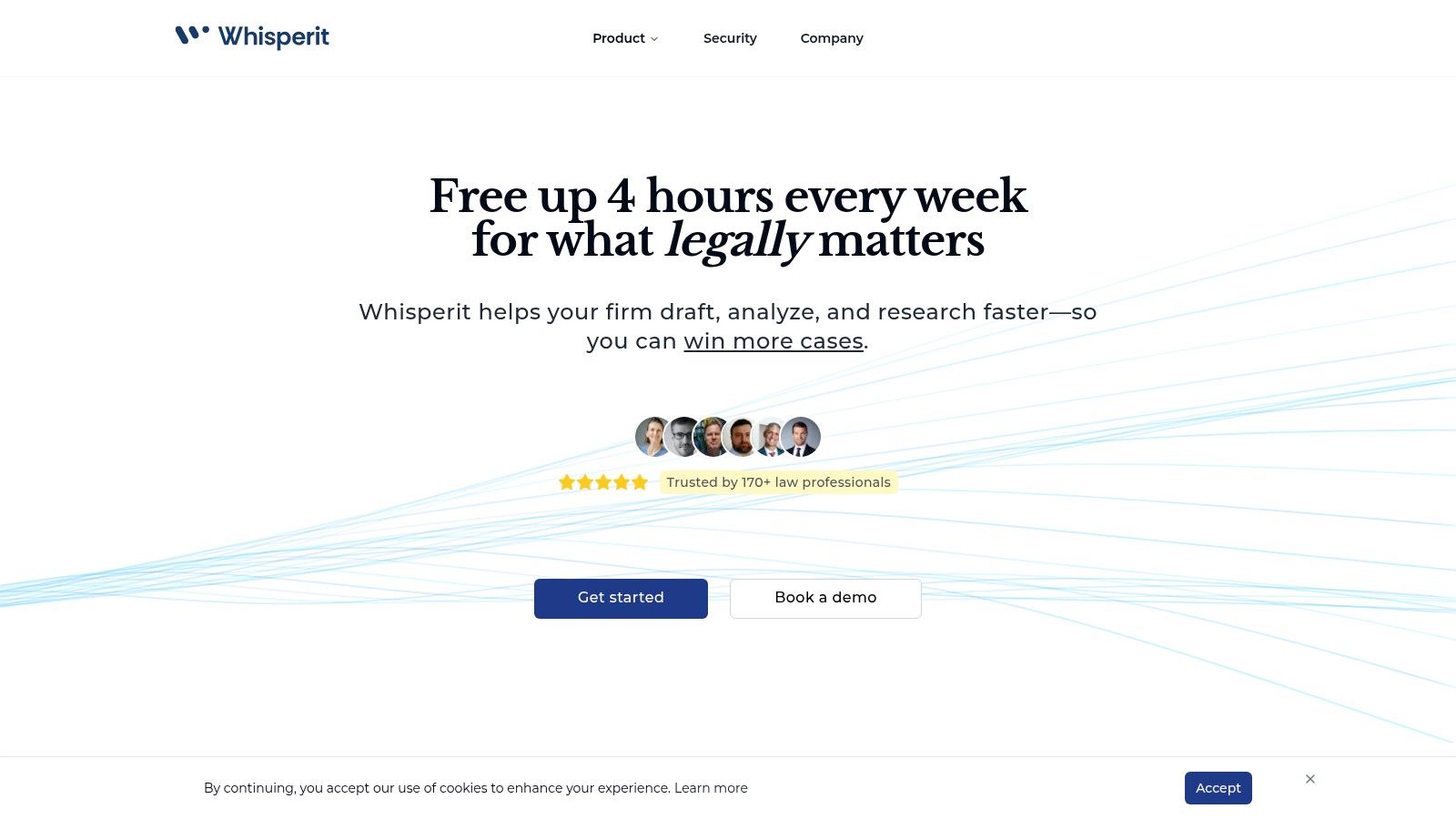
For legal professionals burdened by extensive research, drafting, and case management, Whisperit offers a transformative solution. Imagine dictating complex legal briefs on your commute, having them transcribed and analyzed automatically, and then collaborating with your team in real-time, all within a secure and compliant platform. This is the reality Whisperit delivers. Its advanced voice-to-text dictation capabilities, coupled with AI-driven transcription, drastically reduce the time spent on note-taking and document preparation. The platform's intelligent case analysis feature extracts crucial information like case parties and key events from various file formats, saving countless hours of manual review. Further, its integrated legal research capabilities provide instant access to extensive databases, empowering lawyers to quickly find relevant precedents and statutes, strengthening their arguments and expediting the research process.
Healthcare providers, often overwhelmed by patient documentation and administrative tasks, can also significantly benefit from Whisperit. By streamlining the creation and management of patient records, medical reports, and compliance documentation, Whisperit frees up healthcare professionals to focus on patient care. The platform's secure and compliant infrastructure ensures the confidentiality of sensitive patient data, aligning with stringent industry regulations like HIPAA. While not as specifically tailored to healthcare as it is to legal, the core features of dictation, transcription, and secure collaboration provide a solid foundation for improved workflow efficiency in medical settings.
Compliance officers face the constant challenge of staying up-to-date with ever-evolving regulations and maintaining meticulous documentation. Whisperit helps simplify this process by providing a centralized platform for creating, managing, and analyzing compliance-related documents. The platform's robust search capabilities facilitate quick access to specific information, while its real-time collaboration features enable seamless teamwork across departments. This streamlined workflow ensures that compliance tasks are handled efficiently and effectively, minimizing risks and enhancing organizational integrity.
One of Whisperit's key strengths lies in its robust security infrastructure. Hosted on Swiss servers, the platform adheres to strict data privacy regulations, including GDPR and SOC 2 compliance. This commitment to data security makes Whisperit a trustworthy choice for industries dealing with highly sensitive information. The platform employs end-to-end encryption, safeguarding data both in transit and at rest.
Whisperit boasts an impressive track record, with over 170 legal professionals already benefiting from its time-saving and cost-effective solutions. Some firms have reported annual savings of up to CHF 750,000, demonstrating the platform's potential to deliver a substantial return on investment. While primarily optimized for legal professionals, the core functionality of Whisperit can certainly benefit other sectors, though some may find the legal-specific features less relevant.
One minor drawback is the lack of transparent pricing information on the website. Interested users need to book a demo to obtain detailed pricing, which may be a slight inconvenience for some. Regarding technical requirements, Whisperit is a cloud-based platform, accessible through a web browser, minimizing the need for complex installations or IT infrastructure.
Implementing Whisperit is designed to be straightforward. The platform's intuitive interface and user-friendly design facilitate a smooth onboarding process. While dedicated training may not be strictly necessary, Whisperit offers resources and support to help users maximize the platform's capabilities. For larger organizations or those with specific integration needs, Whisperit provides tailored implementation support to ensure a seamless transition.
In conclusion, Whisperit presents a compelling document workflow solution for professionals seeking to enhance productivity, improve accuracy, and strengthen security. Its AI-powered features, combined with robust security measures and proven cost savings, make it a valuable asset for legal professionals, healthcare providers, and compliance officers alike. While the legal focus might limit its appeal for some sectors, and the lack of transparent pricing requires a demo, the overall value proposition of Whisperit is undeniable for those operating in document-heavy environments. You can explore Whisperit further by visiting their website: https://whisperit.ai
2. Microsoft Power Automate (formerly Microsoft Flow)
Microsoft Power Automate is a powerful document workflow solution that empowers organizations to automate repetitive tasks, streamline processes, and improve overall efficiency. As a cloud-based service, it’s easily accessible and allows both technical and non-technical users – often referred to as "citizen developers," – to build automated workflows across a wide range of applications and services. This makes it a particularly valuable tool for busy professionals in fields like legal, healthcare, and security/compliance who often grapple with document-heavy processes. Power Automate excels in its ability to integrate smoothly within the Microsoft 365 ecosystem and connect with hundreds of other applications, allowing organizations to create sophisticated document workflows without needing extensive coding expertise. This allows your team to focus on higher-value tasks, rather than manual document processing.

Consider the following practical applications for legal professionals, healthcare providers, and security and compliance officers:
- Legal Professionals: Automating the process of reviewing and approving contracts, managing legal documents, and tracking deadlines. Power Automate can automatically route contracts for review and signature, saving valuable time and reducing the risk of errors.
- Healthcare Providers: Streamlining patient onboarding, managing medical records, and automating appointment reminders. For example, a workflow could be created to automatically extract data from patient forms and populate electronic health records.
- Security and Compliance Officers: Automating security audits, incident reporting, and compliance checks. Power Automate can help ensure that all necessary documentation is collected and reviewed in a timely manner, reducing the risk of non-compliance.
Power Automate provides a wealth of features designed to simplify document workflow creation and management:
- Pre-built templates: Jumpstart your automation efforts with templates for common document workflows such as document approval, electronic signatures, and file management. This reduces the need for starting from scratch and accelerates implementation.
- Extensive connector library: Integrate with over 400 connectors, including essential services like SharePoint, OneDrive, Dynamics 365, Salesforce, and numerous third-party applications. This seamless connectivity empowers organizations to create cross-platform workflows and automate processes across their entire technology stack.
- AI Builder: Leverage the power of artificial intelligence for intelligent document processing and form recognition. Extract data from documents, automate data entry, and classify documents based on their content – all without manual intervention.
- Approval workflows: Design customizable approval workflows with routing, escalation, and notifications to ensure timely reviews and approvals. Define specific approvers, set deadlines, and automate reminder notifications to keep the process moving forward.
- Mobile app: Manage and monitor your workflows on the go with the Power Automate mobile app. This provides flexibility and allows you to stay informed and take action even when away from your desk.
Pros: Deep integration with the Microsoft ecosystem provides a seamless experience for organizations already utilizing Microsoft 365. The user-friendly drag-and-drop interface allows even non-technical users to create workflows with ease. The extensive connector library and AI-powered document processing capabilities offer powerful automation possibilities.
Cons: While Power Automate offers affordable plans for basic usage, costs can escalate with high-volume usage and more advanced features. Highly complex workflows may require more advanced coding and customization than the platform's visual interface allows. While usable standalone, a Microsoft 365 subscription unlocks the full potential of Power Automate, especially regarding integration with other Microsoft services.
Pricing: Microsoft Power Automate offers various pricing plans, including per-user plans and per-flow plans, catering to different organizational needs and budgets. Specific pricing details can be found on the Microsoft website.
Technical Requirements: As a cloud-based service, Power Automate requires a stable internet connection. Specific system requirements for using the desktop and mobile apps can be found on the Microsoft website.
For those interested in diving deeper into the world of automating repetitive tasks with this tool, Learn more about Microsoft Power Automate (formerly Microsoft Flow).
Microsoft Power Automate offers a robust and versatile solution for organizations seeking to implement efficient document workflow solutions. Its user-friendly interface, extensive integration capabilities, and AI-powered features make it a valuable asset for businesses of all sizes looking to streamline operations and improve productivity. You can explore the platform and its capabilities further at https://powerautomate.microsoft.com.
3. DocuSign
DocuSign is a prominent player in the document workflow solutions landscape, recognized globally for its robust electronic signature capabilities. It goes beyond simply facilitating e-signatures, offering a comprehensive platform for managing the entire agreement lifecycle, from preparation and negotiation to signing, storage, and beyond. This makes it a powerful tool for organizations, particularly in sectors like legal, healthcare, and compliance, looking to digitize and streamline complex document-driven processes. DocuSign's focus on automation translates to increased efficiency, reduced errors, and enhanced security, making it a worthwhile consideration for businesses seeking to modernize their document workflows.
For legal professionals, DocuSign offers a secure and legally compliant way to manage contracts, agreements, and other vital documents. Its advanced authentication features, including knowledge-based authentication and ID verification, ensure the integrity of signatures. The comprehensive audit trails provide a detailed record of every action taken within the document workflow, which is crucial for legal compliance and dispute resolution. Healthcare providers can leverage DocuSign to streamline patient consent forms, medical records releases, and other critical documentation, ensuring HIPAA compliance while enhancing the patient experience. Security and compliance officers will appreciate the robust security features and granular access controls, which help mitigate risks associated with sensitive information.
DocuSign offers a range of plans to cater to different needs and budgets. The Personal plan is suitable for individuals with basic signing needs, while the Standard and Business Pro plans offer more advanced features like document template management and integrations. For larger organizations with complex requirements, the Enterprise plan provides custom solutions and dedicated support. Specific pricing details are available on the DocuSign website, allowing potential users to tailor their subscriptions to their specific document workflow solutions needs. From a technical perspective, DocuSign is accessible via web browsers and mobile apps, offering flexibility for users on the go. It integrates seamlessly with popular CRM, ERP, and productivity applications, such as Salesforce, Microsoft Dynamics 365, and Google Workspace, further enhancing its utility within existing business ecosystems.
Implementing DocuSign is generally straightforward, with intuitive interfaces for both senders and signers. The platform provides pre-built templates for common document types, simplifying the document preparation process. Users can also create custom templates to align with their specific requirements. For more complex integrations and workflow automation, DocuSign offers a robust API and developer resources.
While DocuSign offers a powerful suite of features, it's important to consider its limitations. The premium pricing structure can be a barrier for smaller businesses or those with limited budgets. Alternatives like HelloSign or PandaDoc offer competitive features at a lower cost point. Additionally, while DocuSign excels at electronic signatures and basic document management, its workflow automation capabilities beyond the signing process are somewhat limited. For organizations requiring extensive workflow customization, exploring other document workflow solutions might be beneficial.
Despite these limitations, DocuSign’s position as an industry leader, its strong legal compliance, and comprehensive features justify its place on this list. Its intuitive user experience, robust API, and extensive integrations make it a valuable tool for organizations across various industries. By automating manual processes, enhancing security, and streamlining workflows, DocuSign contributes significantly to optimizing document management and improving overall business efficiency. For businesses seeking a comprehensive and reliable solution for their document workflow needs, DocuSign is undoubtedly worth considering. You can explore their offerings and request a demo on their website: https://www.docusign.com
4. Nintex: Robust Document Workflow Solutions for the Enterprise
Nintex is a powerful platform specifically designed for enterprise-grade document workflow solutions. It offers a comprehensive suite of tools that streamline complex business processes, automate document management, and facilitate intelligent workflows across various departments and systems. For organizations dealing with high volumes of documents and intricate approval processes, Nintex provides the robustness and control necessary to optimize efficiency and ensure compliance. This makes it a particularly strong choice for legal professionals, healthcare providers, and security and compliance officers who require secure, auditable, and efficient document management.
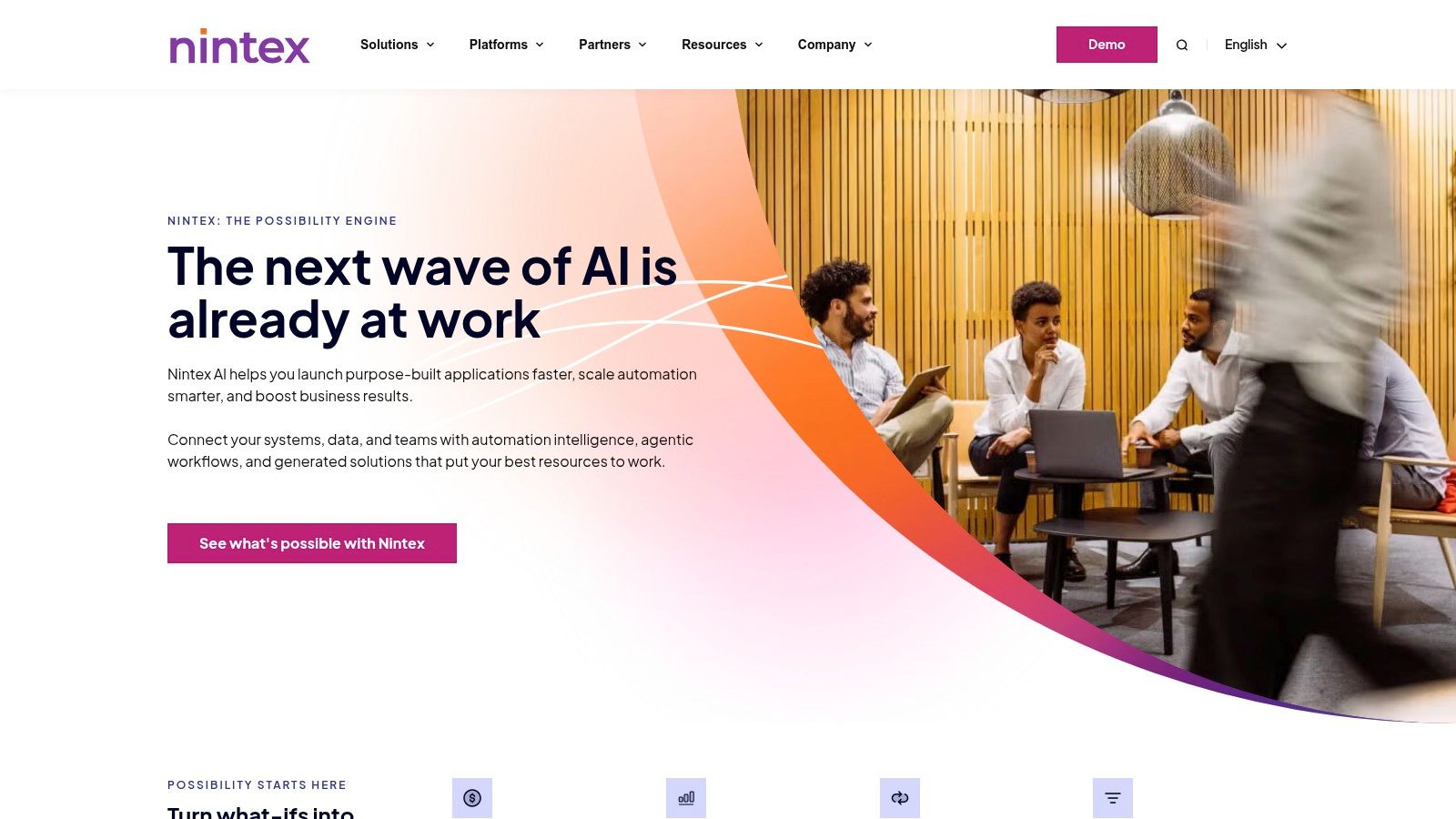
One of Nintex's key strengths lies in its ability to handle complex document approval and routing processes, a critical requirement in many regulated industries. Imagine a legal firm managing hundreds of contracts simultaneously. With Nintex, they can automate the entire contract lifecycle, from initial drafting and review through final approval and signature. Automated reminders, escalations, and audit trails ensure that no document gets lost in the shuffle and that all actions are tracked for compliance purposes. Similarly, healthcare providers can use Nintex to streamline patient record management, ensuring that sensitive information is securely routed to the appropriate personnel and that all HIPAA regulations are met. Security and compliance officers can leverage Nintex to automate policy enforcement, incident reporting, and risk assessments, ensuring a consistent and auditable approach to security management.
Nintex achieves this through a range of features designed for sophisticated workflow automation. Its visual workflow designer, with drag-and-drop functionality, allows users to create and modify workflows without extensive coding knowledge. The advanced form builder incorporates conditional logic, enabling dynamic forms that adapt based on user input, significantly improving data accuracy and user experience. Document generation and template management features further enhance efficiency by automating the creation of standardized documents. For instance, a legal team could automate the creation of non-disclosure agreements, populating them with client-specific information drawn from a central database.
Beyond automation, Nintex provides robust process analytics and reporting dashboards. This functionality offers valuable insights into workflow performance, identifying bottlenecks and areas for improvement. These insights are invaluable for optimizing processes, reducing turnaround times, and increasing overall operational efficiency. Enterprise-grade security and compliance features, including granular access controls and audit trails, ensure data integrity and regulatory compliance.
While Nintex offers numerous advantages, it's important to acknowledge its potential drawbacks. The platform’s comprehensive functionality can translate into a steeper learning curve, especially for users creating complex workflows. While basic workflows are relatively easy to set up, mastering the more advanced features requires technical expertise. This can lead to increased implementation time and potentially higher training costs. Additionally, Nintex's robust features come at a price. The platform's pricing structure, while suitable for large enterprises, might be less accessible for smaller businesses with limited budgets. You can learn more about Nintex and its functionalities for document automation.
Implementing Nintex effectively requires careful planning and consideration. Organizations should clearly define their workflow requirements and identify key stakeholders involved in the process. A phased implementation approach, starting with simpler workflows and gradually incorporating more complex automation, is often recommended. Engaging with Nintex's professional services team or certified partners can help ensure a smooth implementation process and maximize the platform's potential.
While specific pricing and technical requirements are not readily available publicly, Nintex offers tailored solutions based on individual organizational needs. Contacting their sales team directly is the best way to obtain specific pricing information and discuss technical requirements related to your environment.
In comparison to other document workflow solutions, Nintex stands out with its robust features, enterprise-grade security, and comprehensive process analytics. While platforms like Kissflow and ProcessMaker offer user-friendly interfaces and lower price points, they may lack the depth of functionality required for complex enterprise workflows. Nintex's focus on enterprise-level automation makes it a compelling choice for organizations needing robust, scalable, and secure document workflow solutions.
5. SharePoint
Microsoft SharePoint stands as a robust document workflow solution, particularly for organizations already entrenched in the Microsoft ecosystem. As a web-based collaborative platform seamlessly integrating with Microsoft Office, SharePoint offers a secure repository to store, organize, share, and access information from any device. Its comprehensive suite of features makes it a compelling option for those seeking a centralized, manageable system for document-driven processes. It earns its place on this list due to its powerful combination of collaboration, automation, and security features, especially beneficial for legal professionals, healthcare providers, and security and compliance officers.
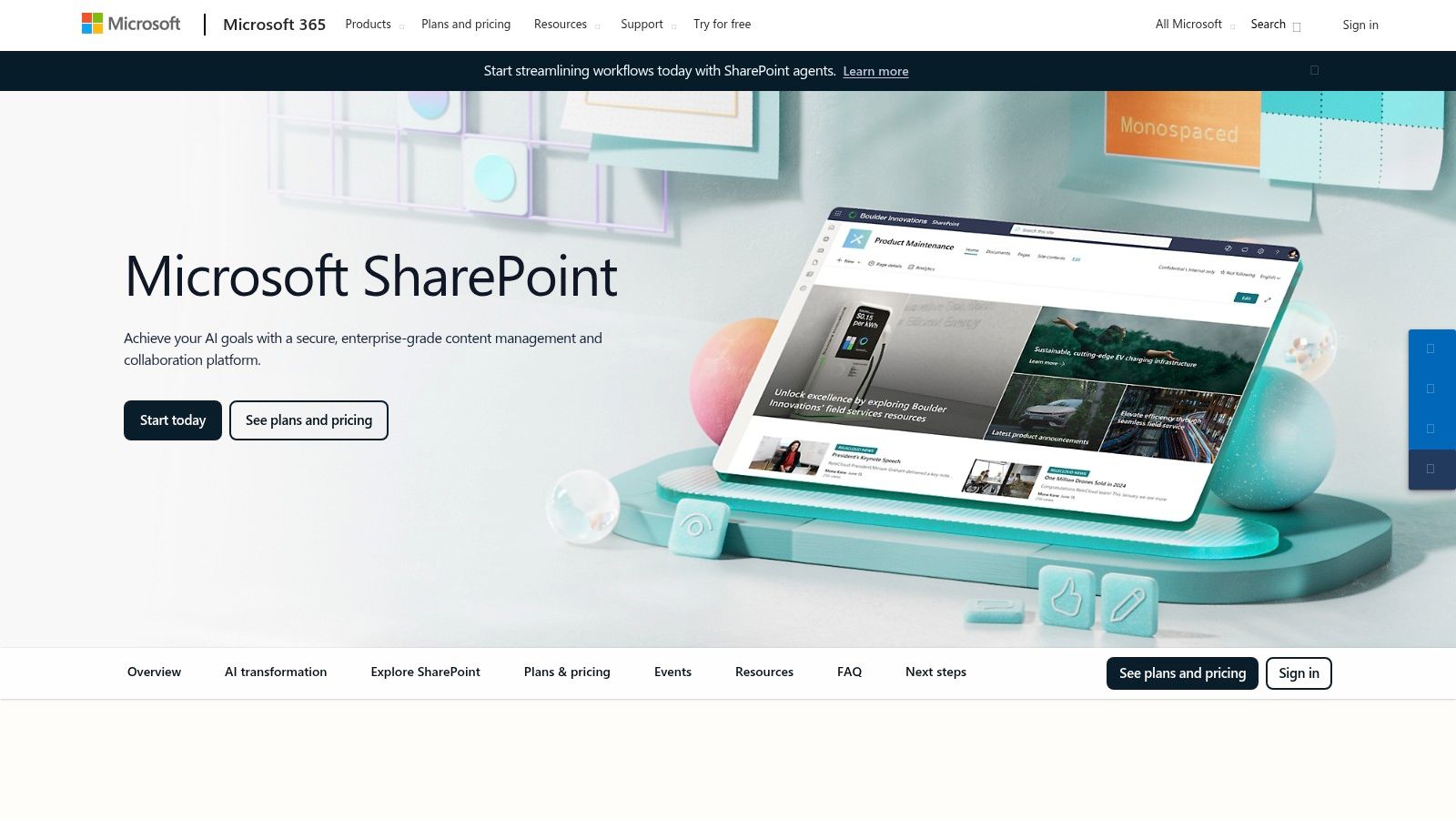
SharePoint’s document workflow capabilities extend far beyond simple file storage. Robust version control ensures that every iteration of a document is tracked, preventing confusion and facilitating easy retrieval of previous versions. Built-in approval workflows automate the review and approval process, routing documents to the appropriate stakeholders and ensuring compliance with internal policies. This is particularly valuable for legal professionals managing contracts or healthcare providers tracking patient records. Automated routing streamlines document distribution, eliminating manual handoffs and reducing the risk of errors. Content management features allow for the organization of documents into libraries and folders, making it easy to locate and retrieve information. Metadata management further enhances organization, allowing users to tag documents with relevant keywords and properties for easier searchability.
For legal professionals dealing with sensitive client data, security is paramount. SharePoint addresses this with robust permission management and security controls, allowing administrators to granularly control access to documents and information. This ensures that only authorized individuals can view, edit, or share specific files, maintaining confidentiality and compliance. Healthcare providers, bound by HIPAA regulations, can leverage these security features to safeguard protected health information (PHI). Similarly, security and compliance officers can utilize SharePoint to manage and track compliance-related documents, ensuring adherence to industry regulations and internal policies. Learn more about SharePoint for specific best practices.
SharePoint offers numerous features beneficial to various document workflow solutions, including document libraries with version control and check-in/check-out functionalities. This allows multiple users to collaborate on documents while preventing conflicts and ensuring version integrity. Built-in approval workflows and content approval streamline review processes, ensuring that documents meet quality standards before publication or distribution. Integration with Microsoft 365 apps like Word, Excel, and PowerPoint enables seamless document creation, editing, and collaboration within the SharePoint environment. Furthermore, integration with Power Platform allows for the development of custom workflows and automation, tailoring SharePoint to specific organizational needs.
While SharePoint is a powerful tool, it has its limitations. One key drawback is the complexity of setup and customization. Configuring SharePoint for specific workflow requirements can require specialized knowledge and often involves IT support. The user interface, while functional, can feel outdated compared to more modern document management solutions. Additionally, developing advanced workflows often necessitates SharePoint expertise, potentially requiring organizations to invest in training or hire specialized personnel.
SharePoint's pricing is tied to Microsoft 365 subscriptions, meaning the cost varies depending on the chosen plan. Many enterprise-level Microsoft 365 subscriptions include SharePoint, making it a cost-effective solution for organizations already utilizing the Microsoft suite. Technical requirements are minimal, primarily requiring a compatible web browser and an active Microsoft 365 subscription.
Compared to other document workflow solutions like Google Workspace or dedicated document management systems (DMS), SharePoint excels in its deep integration with the Microsoft ecosystem. While Google Workspace offers a simpler, more user-friendly interface, it lacks the granular security and compliance features of SharePoint. Dedicated DMS solutions often offer more specialized features for document management but can be significantly more expensive.
For organizations seeking to implement SharePoint for document workflow solutions, a phased approach is recommended. Begin by identifying key workflows and processes that can benefit from automation and centralization. Then, pilot SharePoint with a small team to test and refine workflows before rolling it out to the wider organization. Investing in training for end-users can also significantly improve adoption and maximize the benefits of the platform. This structured implementation strategy helps organizations leverage SharePoint's strengths while mitigating potential challenges associated with its complexity.
6. ProcessMaker
ProcessMaker is a robust low-code business process automation (BPA) platform specifically designed to empower organizations to design, automate, and optimize their document workflows and broader business processes. It provides a comprehensive suite of tools, including a visual process designer, a dynamic form builder, and a powerful workflow engine capable of managing complex document routing, approvals, and integrations with existing enterprise systems. This makes it a strong contender for organizations looking for comprehensive document workflow solutions. For professionals in legal, healthcare, and security/compliance fields, ProcessMaker offers the ability to streamline document-heavy processes, ensuring accuracy, efficiency, and adherence to regulatory requirements.
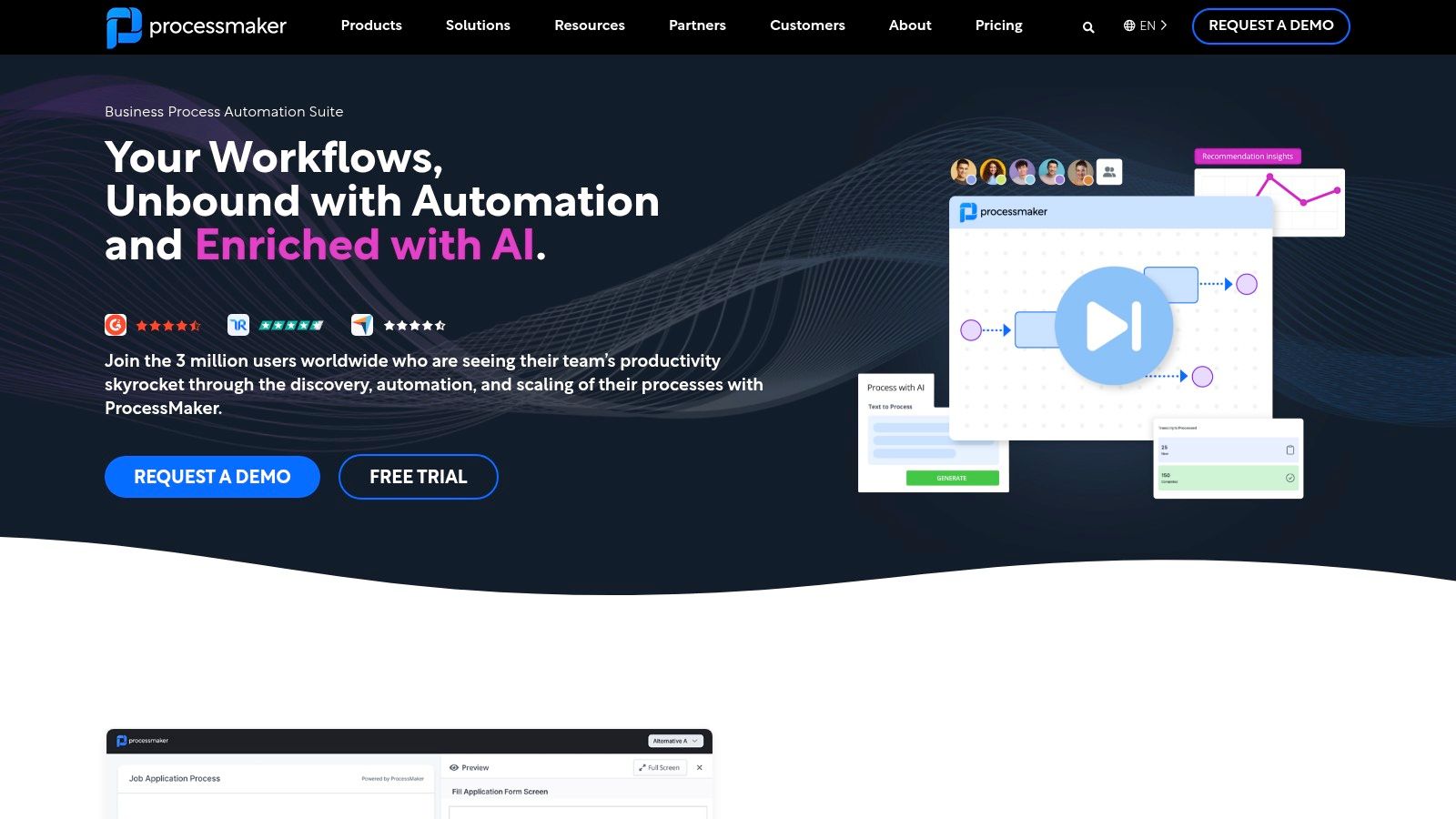
One of ProcessMaker's core strengths lies in its low-code approach. The visual BPMN 2.0 process designer allows users to model complex workflows using drag-and-drop functionality, minimizing the need for extensive coding expertise. This is particularly advantageous for organizations without large IT departments or those seeking to rapidly deploy document workflow solutions. For example, a legal team could use ProcessMaker to automate the contract approval process, routing documents to the appropriate stakeholders based on predefined rules and criteria, without requiring custom code development. Similarly, healthcare providers could streamline patient onboarding, managing document collection and approvals electronically, improving efficiency and reducing errors. Security and Compliance Officers can benefit by automating policy distribution and attestation workflows, ensuring everyone acknowledges and adheres to the latest regulations.
The dynamic form builder, with its conditional logic capabilities, enables the creation of intelligent forms that adapt based on user input, further enhancing the automation potential. Imagine a scenario where a healthcare provider needs to collect different information based on the patient's insurance type. ProcessMaker's dynamic forms can handle this complexity, ensuring the relevant fields are displayed based on the selected insurance plan. This dynamic adaptability translates to more efficient data collection and fewer errors in document workflows.
ProcessMaker offers flexible deployment options, including cloud-based and on-premise installations, catering to diverse organizational needs and security preferences. While pricing information isn't readily available on their website, it is generally considered competitive, especially for mid-market companies. This makes it a more accessible option compared to some high-end enterprise solutions, while still offering robust features for managing complex document workflows.
Integrating with existing enterprise systems is crucial for any document workflow solution, and ProcessMaker delivers on this front through its REST API and webhook integrations. This allows seamless connectivity with CRM systems, ERP software, and other business-critical applications, enabling a unified and automated document workflow across the entire organization. For instance, a security and compliance officer could integrate ProcessMaker with their identity management system to automatically trigger access reviews based on specific events or timeframes.
While ProcessMaker boasts a strong set of features, there are some areas for improvement. The library of pre-built templates, while growing, is less extensive than some competitors, requiring users to build more workflows from scratch. The user interface, although functional, could benefit from modernization to enhance user experience. Finally, the ecosystem of third-party integrations, while sufficient for many use cases, is smaller than some alternatives in the market.
Implementing ProcessMaker requires some upfront planning and configuration. Organizations should clearly define their document workflow requirements, map out existing processes, and identify key stakeholders involved in the automation process. Leveraging ProcessMaker’s robust BPMN 2.0 compliance can help organizations model their processes effectively before implementation. While the low-code nature minimizes coding, some familiarity with process modeling concepts will be beneficial for optimal implementation.
For organizations seeking a powerful and flexible document workflow solution, ProcessMaker presents a compelling option. Its low-code approach, combined with a robust feature set and competitive pricing, makes it an attractive choice, particularly for mid-market companies in legal, healthcare, and security/compliance fields. While some improvements could be made in terms of pre-built templates and user interface, ProcessMaker’s core strengths in visual process design, dynamic forms, and integrations position it as a valuable tool for optimizing document-driven processes and improving organizational efficiency. You can explore more about ProcessMaker on their website: https://www.processmaker.com
7. Kissflow: Streamlining Document Workflows for Enhanced Productivity
Kissflow is a comprehensive digital workplace platform offering a unified solution for workflow automation, process management, and team collaboration. It empowers business users, even those without technical expertise, to design, implement, and manage document workflows efficiently. From simple approvals to complex multi-stage processes, Kissflow provides an intuitive, no-code platform to optimize document handling. This makes it a compelling document workflow solution for professionals in various fields, including legal, healthcare, and security/compliance. For these professionals, streamlining document-heavy processes is crucial for efficiency, compliance, and reducing risk.
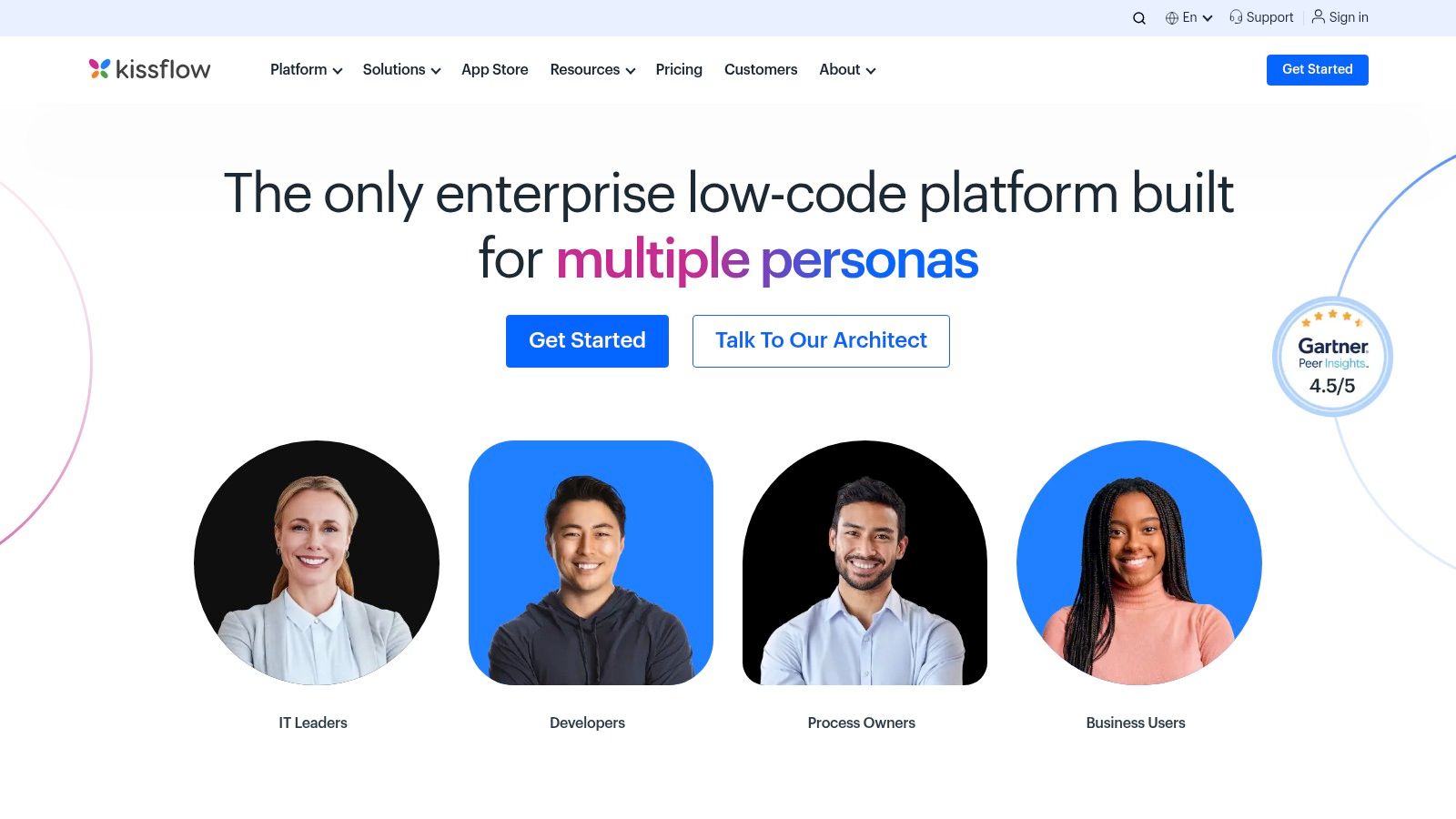
Kissflow stands out with its user-friendly interface and robust automation capabilities. Imagine a legal team managing contract approvals. With Kissflow, they can create a workflow where a contract, once drafted, is automatically routed to the relevant stakeholders for review and approval. Automated notifications ensure timely action, eliminating delays and potential bottlenecks. Similarly, healthcare providers can use Kissflow to manage patient onboarding, ensuring that all necessary documents are collected and processed efficiently, complying with HIPAA regulations. Security and compliance officers can leverage Kissflow for incident reporting and management, creating a streamlined process for documenting, investigating, and resolving security breaches.
One of Kissflow's key strengths lies in its no-code workflow builder. This feature allows users to visually design workflows using drag-and-drop functionality and pre-built templates. This eliminates the need for coding expertise, empowering business users to take control of their document workflows. The platform also includes a form designer with dynamic fields and validations, ensuring data accuracy and consistency. Automated task assignments and notifications keep everyone informed and on track, while real-time collaboration and commenting features facilitate seamless communication throughout the workflow process. An analytics dashboard provides valuable process insights, enabling continuous improvement and optimization. You can learn more about Kissflow and its capabilities in document workflow automation.
Kissflow offers several pricing plans to cater to different needs and budgets, typically ranging from a basic plan for small teams to enterprise-level plans with advanced features and support. Specific pricing details are available on their website. While technical requirements are minimal, a stable internet connection and a modern web browser are sufficient to access and utilize the platform effectively.
Compared to other document workflow solutions like Process Street or Monday.com, Kissflow distinguishes itself through its user-friendliness and focus on no-code workflow creation. While platforms like Process Street offer more robust checklist and SOP management capabilities, Kissflow shines in its ease of use and rapid deployment. Monday.com provides a wider range of integrations, but Kissflow offers a more focused and streamlined approach to workflow automation, particularly suited for document-centric processes.
Implementing Kissflow is relatively straightforward. Begin by identifying the key document workflows you want to automate. Utilize the pre-built templates or design your workflows from scratch using the drag-and-drop builder. Customize forms, configure automated notifications, and define user roles and permissions. Kissflow’s strong customer support and training resources can assist with implementation and onboarding, ensuring a smooth transition.
While Kissflow excels in its user-friendliness and rapid deployment, it's important to be aware of its limitations. Customization options for highly complex enterprise needs might be limited compared to more extensive platforms. The number of integration options is also less than some competitors, and the reporting capabilities, while useful, could be more advanced.
Overall, Kissflow earns its place on this list as a powerful and user-friendly document workflow solution. Its intuitive interface, no-code workflow builder, and robust automation capabilities make it an excellent choice for businesses looking to streamline their document processes, enhance productivity, and improve collaboration. For legal professionals, healthcare providers, and security/compliance officers seeking an easy-to-implement and effective solution for managing document workflows, Kissflow is a strong contender. Visit their website (https://kissflow.com) for more information.
8. K2 (now Nintex K2)
When it comes to robust document workflow solutions, especially for enterprise-level organizations, Nintex K2 (formerly K2) holds a prominent position. This powerful platform offers a comprehensive suite of tools for automating complex business processes, particularly those involving significant document routing, approvals, and management. Its sophisticated features, including a high-performance workflow engine, advanced form services, and robust integration capabilities, make it a strong contender for organizations seeking to streamline their document-centric operations. K2 earns its place on this list due to its ability to handle the intricate demands of large-scale document workflows with a focus on customization, security, and scalability. This makes it particularly attractive to legal professionals, healthcare providers, and security and compliance officers who often deal with sensitive information and stringent regulatory requirements.
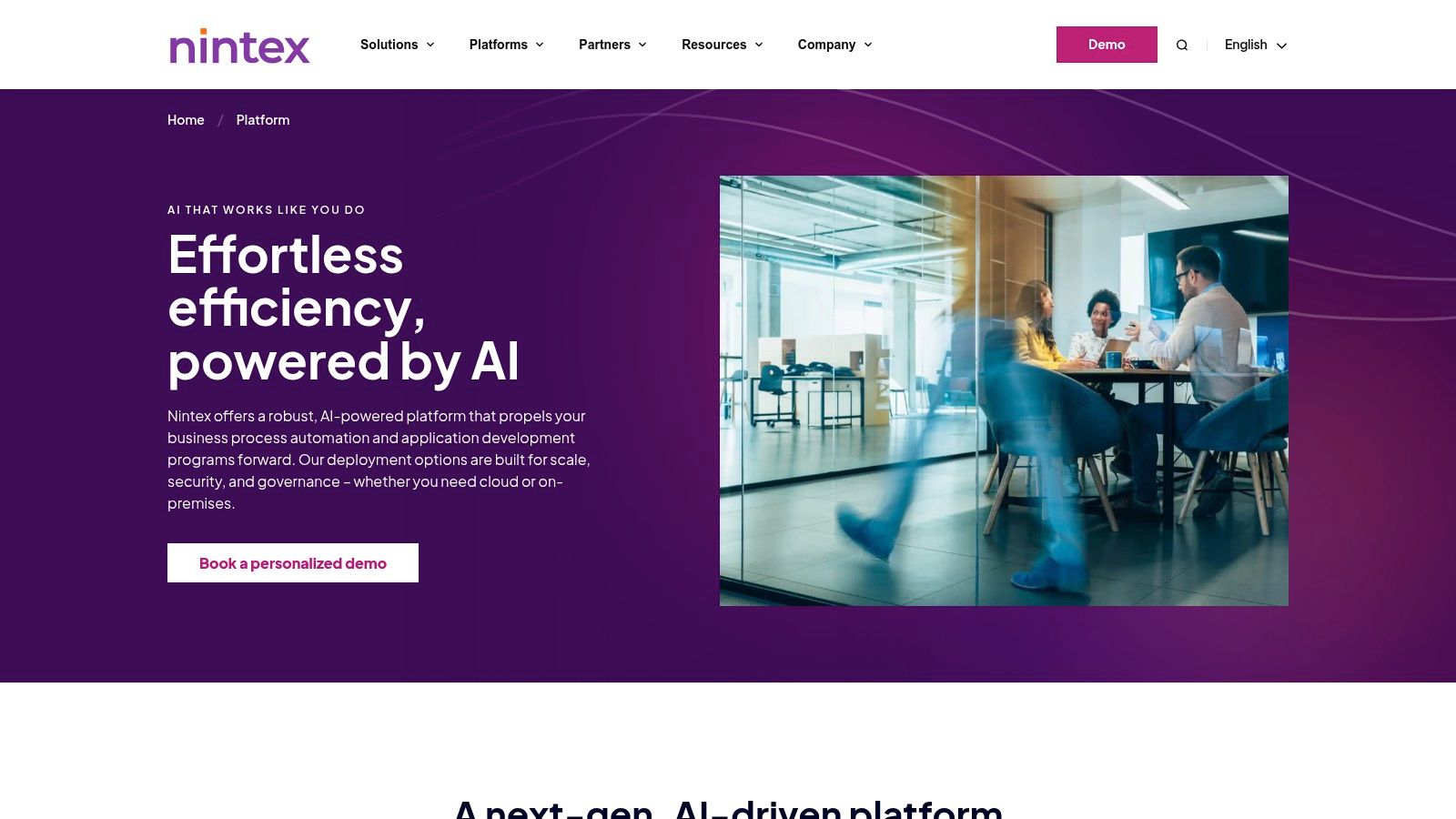
Consider a legal firm managing hundreds of contracts simultaneously. With Nintex K2, they can automate the entire contract lifecycle, from initial drafting and review to final approval and execution. The platform's advanced form services enable the creation of dynamic, responsive forms for data capture, ensuring consistency and accuracy. Workflows can be designed to route contracts automatically to the appropriate stakeholders for review and approval, eliminating manual handoffs and reducing processing time. Furthermore, K2’s robust integration capabilities allow seamless connectivity with existing systems, such as document management systems (DMS) and customer relationship management (CRM) platforms, creating a unified and efficient workflow.
In the healthcare sector, Nintex K2 can streamline patient onboarding processes, ensuring that all necessary documentation is collected, reviewed, and approved efficiently. Automated workflows can route patient forms to physicians, nurses, and administrative staff, minimizing delays and improving patient experience. Security and compliance features, crucial in healthcare, are addressed through K2's enterprise-grade security protocols, ensuring data integrity and patient privacy.
For security and compliance officers, K2 offers a powerful solution for automating policy enforcement and audit trails. Workflows can be configured to trigger automated notifications and approvals based on specific events, ensuring adherence to internal policies and regulatory requirements. The platform’s comprehensive API and integration framework allows for seamless integration with security information and event management (SIEM) systems, further enhancing security posture.
While Nintex K2 offers a compelling set of features, it is important to consider the platform's complexity. Setting up and configuring K2 requires significant technical expertise, and the total cost of ownership can be higher compared to some other document workflow solutions. Implementing K2 often involves engaging with Nintex professional services or certified partners to ensure successful deployment and ongoing support. However, for enterprise environments with complex document workflow needs, the investment in K2 can yield substantial returns in terms of improved efficiency, reduced errors, and enhanced compliance.
Features and Benefits:
- Enterprise Workflow Engine: High-performance processing for complex, high-volume document workflows.
- Advanced Form Services: Responsive design and dynamic forms for efficient data capture.
- Comprehensive API and Integration Framework: Seamless integration with existing systems.
- Workflow Analytics and Business Intelligence: Data-driven insights for process optimization.
- Enterprise Security and Compliance Features: Robust security protocols for data protection.
Pros:
- Highly scalable for enterprise environments
- Robust integration capabilities
- Strong performance for high-volume processes
- Comprehensive developer tools and APIs
Cons:
- Complex setup and configuration
- Requires significant technical expertise
- Higher total cost of ownership
Website: https://www.nintex.com/process-platform/k2-five/
Pricing: Nintex K2 pricing is typically based on the number of users and the specific features required. Contacting Nintex directly for a personalized quote is recommended.
Technical Requirements: Specific technical requirements for Nintex K2 vary based on deployment options (on-premise, cloud, or hybrid). Consulting the official documentation or contacting Nintex support is advised for detailed technical specifications.
Implementation Tips:
- Clearly Define Requirements: Thoroughly analyze your document workflow needs before implementing K2.
- Engage with Experts: Consider working with Nintex professional services or certified partners for implementation and support.
- Pilot Project: Start with a pilot project to test and refine your workflows before full-scale deployment.
- Training: Invest in training for your team to maximize the benefits of K2.
Nintex K2 stands out as a comprehensive and powerful document workflow solution for enterprise-level organizations. While its complexity may present a challenge, its robust features and scalability make it a valuable investment for businesses seeking to optimize their document-centric processes and achieve significant operational efficiencies. For legal, healthcare, and compliance professionals, its robust security features and integration capabilities further solidify its position as a top contender in the document workflow solutions landscape.
9. Zapier
Zapier, a leading web-based automation tool, empowers users to connect thousands of apps and services, creating automated workflows known as "Zaps." While not solely a dedicated document workflow solution, Zapier's versatility and extensive integrations make it a powerful contender for streamlining simple to moderately complex document-centric processes, particularly for legal professionals, healthcare providers, and security and compliance officers. By seamlessly linking document management systems, email platforms, cloud storage, and various business applications, Zapier offers a no-code approach to automating repetitive tasks and optimizing document workflows.
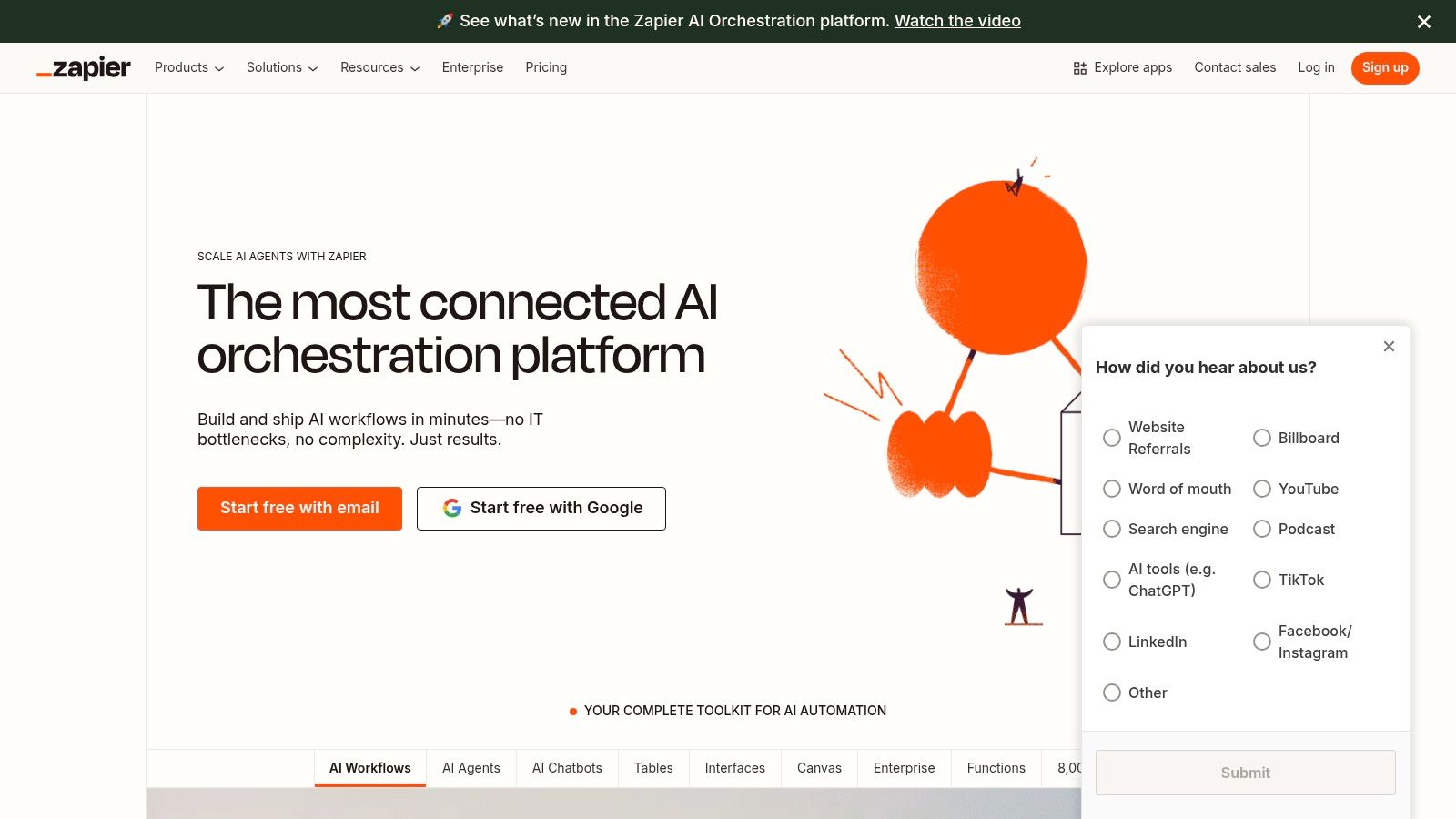
For legal professionals burdened with document-heavy processes, Zapier can automate tasks like saving email attachments to cloud storage (e.g., Google Drive, Dropbox), generating and distributing contracts via e-signature platforms (e.g., DocuSign, HelloSign), and automatically updating case management systems with new client information. Imagine a new client email arriving; Zapier can automatically extract relevant data, create a new client record in your CRM, and save the attached documents to a designated cloud folder, all without manual intervention. This automation saves valuable time and reduces the risk of human error, allowing legal professionals to focus on more strategic work.
Healthcare providers facing stringent compliance requirements can leverage Zapier to automate document workflows related to patient records. For instance, a Zap can be created to automatically transfer patient intake forms from online forms to secure HIPAA-compliant storage, trigger notifications for required approvals, and update electronic health record (EHR) systems with the latest patient data. This automation ensures accurate and timely processing of patient information, strengthens compliance efforts, and frees up administrative staff.
Security and compliance officers dealing with sensitive information and intricate approval processes can utilize Zapier to create automated workflows for document review and authorization. When a new policy document is uploaded to a shared drive, Zapier can trigger a notification to the relevant stakeholders, initiate an approval workflow, and automatically archive the document after the final approval. This automation ensures that all documents are reviewed and approved by the appropriate personnel, strengthens version control, and simplifies audit trails.
Zapier offers a vast library of integrations with over 5000 apps and services, allowing users to connect virtually any tool involved in their document workflows. Its multi-step "Zaps" enable the creation of complex automated sequences, while conditional logic and filtering capabilities allow for granular control over the workflow execution. Data formatting and transformation tools further enhance Zapier's ability to manipulate document data, ensuring compatibility between different applications.
Zapier's pricing model caters to various needs and budgets. Free plans are available for basic usage, while paid plans offer increased task limits, access to premium features, and higher usage allowances. This affordability makes Zapier an attractive option for small businesses and individual users. While high-volume usage can increase costs, the potential time savings and efficiency gains often justify the investment.
While Zapier excels in its breadth of integrations and ease of use for basic workflows, it's crucial to acknowledge its limitations. Compared to dedicated document workflow platforms, Zapier's workflow complexity is somewhat constrained. It lacks built-in form builders or document storage capabilities, relying on integrations with other services to fulfill these needs. For highly intricate, document-intensive processes, dedicated workflow solutions might offer a more robust and tailored approach.
Implementing Zapier is relatively straightforward. Users can browse pre-built Zap templates or create custom Zaps using a user-friendly interface. Extensive documentation and an active community provide ample resources for troubleshooting and learning advanced techniques. However, users should carefully consider the logical flow of their workflows and potential dependencies between different applications to ensure seamless automation.
In conclusion, Zapier earns its place on this list of document workflow solutions due to its impressive versatility, extensive integrations, and ease of use. While it might not be the ideal solution for every scenario, particularly those involving highly complex workflows, its affordability and no-code approach make it a powerful tool for automating document-centric processes and boosting efficiency for legal professionals, healthcare providers, and security and compliance officers. Its website, https://zapier.com, provides further information and resources.
10. Laserfiche
Laserfiche is a robust enterprise content management (ECM) and business process automation solution that consolidates document management, records management, and workflow automation into a single, unified platform. This makes it a powerful document workflow solution for organizations needing to streamline their document-centric processes. Its strength lies in serving regulated industries like healthcare and government, as well as organizations with stringent compliance and audit requirements. If your organization struggles with managing large volumes of documents, complex approval processes, or maintaining compliance in a highly regulated environment, Laserfiche could be the ideal solution.
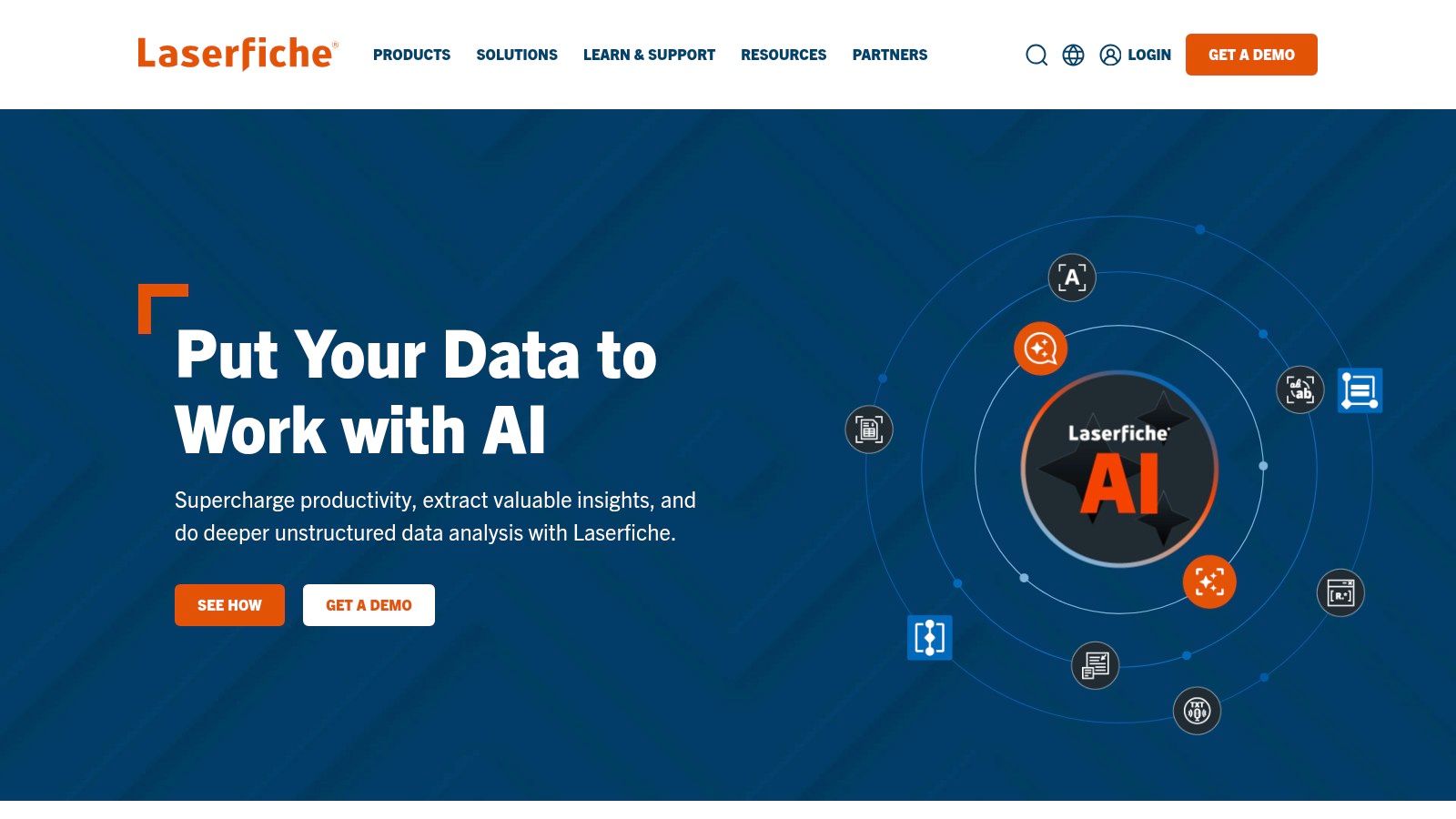
Laserfiche’s comprehensive feature set enables it to handle the entire document lifecycle, from initial creation and capture through archiving and disposal. Its full-text search capabilities make finding information within the system quick and easy, even across massive repositories. For example, legal professionals can rapidly locate specific case files, healthcare providers can quickly access patient records, and compliance officers can efficiently retrieve audit trails. The visual workflow designer, combined with a powerful business rules engine, allows organizations to automate complex document-driven processes, such as contract approvals, invoice processing, and records retention. This automation eliminates manual tasks, reduces errors, and accelerates turnaround times. You can Learn more about Laserfiche and how it supports automated document processes.
One of Laserfiche’s key strengths is its robust records management capabilities. Its retention scheduling features ensure that organizations comply with regulatory requirements for document retention and disposal. This is particularly important in industries like healthcare and finance, where strict recordkeeping rules are in place. Furthermore, Laserfiche's electronic forms functionality streamlines data capture and validation, improving data accuracy and efficiency. Imagine a hospital using Laserfiche forms for patient intake – this eliminates paper forms, reduces manual data entry errors, and ensures consistent data capture across the organization.
For security and compliance officers, Laserfiche offers comprehensive audit trail capabilities, providing detailed logs of all document access and modifications. This level of transparency is crucial for demonstrating compliance with industry regulations and internal policies. Moreover, the platform's scalable architecture can accommodate the needs of both small and large organizations, allowing for growth and adaptation over time.
While Laserfiche offers a powerful suite of features, it's important to consider its potential drawbacks. Compared to cloud-native document workflow solutions, Laserfiche typically comes with a higher price tag. Pricing is generally based on the number of users and features required and is often provided through custom quotes. Additionally, implementing Laserfiche can be complex for smaller organizations that may lack the internal IT resources needed for a successful deployment. The user interface, while functional, can feel less intuitive and modern compared to some newer platforms. However, Laserfiche provides excellent customer support and training resources to help users navigate the platform and maximize its potential.
In terms of technical requirements, Laserfiche can be deployed on-premises or in a private cloud environment. On-premises deployments require Windows Server and SQL Server, while private cloud deployments leverage a similar infrastructure managed by the organization or a third-party provider. System requirements vary based on the organization's size and usage patterns.
Compared to other enterprise content management solutions like M-Files and DocuWare, Laserfiche differentiates itself with its strong focus on regulated industries and robust records management capabilities. While M-Files and DocuWare offer similar document management and workflow automation features, Laserfiche's comprehensive compliance and audit tools make it a compelling choice for organizations with stringent regulatory requirements.
For organizations considering implementing Laserfiche, it's essential to plan carefully. Start by defining your specific document workflow needs and identifying the key processes you want to automate. Engage with Laserfiche directly or with a certified reseller to assess your requirements and develop a tailored implementation plan. Investing in adequate training for your staff will be crucial for ensuring user adoption and maximizing the return on your investment. By carefully considering these factors, organizations can leverage Laserfiche to streamline their document workflows, improve compliance, and enhance operational efficiency.
Document Workflow Solutions Feature Comparison
| Product | Core Features & Capabilities | User Experience & Quality ★ | Value & Pricing 💰 | Target Audience 👥 | Unique Selling Points ✨ |
|---|---|---|---|---|---|
| 🏆 Whisperit | AI dictation, transcription, legal research, Swiss-hosted security | ★★★★☆ Highly praised by legal pros | 💰 Demo-based pricing; high ROI | 👥 Legal, healthcare, compliance | ✨ 3x faster doc workflows, GDPR & SOC 2, real-time collaboration |
| Microsoft Power Automate | Workflow automation, 400+ connectors, AI document processing | ★★★★ User-friendly drag-drop | 💰 Can be costly at scale | 👥 Business users, MS 365 customers | ✨ Deep MS365 integration, AI builder |
| DocuSign | E-signatures, agreement lifecycle, advanced security | ★★★★ Industry leader, intuitive UX | 💰 Premium pricing | 👥 Enterprises needing compliant e-sign | ✨ Legally binding e-sign, audit trails |
| Nintex | Visual workflow design, document generation, analytics | ★★★★ Customizable, enterprise-grade | 💰 Higher cost, complex setup | 👥 Enterprises with complex workflows | ✨ Strong SharePoint & Office365 integration |
| SharePoint | Document libraries, version control, approval workflows | ★★★★ Scalable, MS ecosystem suited | 💰 Included in MS365 subscriptions | 👥 Enterprises, MS users | ✨ Tight MS Office & Power Platform integration |
| ProcessMaker | Low-code BPMN process design, workflow analytics | ★★★ Visual designer, less modern UI | 💰 Competitive mid-market pricing | 👥 Mid-market companies | ✨ True low-code platform, cloud/on-premise |
| Kissflow | No-code workflow, form builder, automation, collaboration | ★★★★ Very user-friendly interface | 💰 Good value for money | 👥 Business users, SMBs | ✨ Quick setup, pre-built templates |
| K2 (now Nintex K2) | Enterprise workflow engine, API, workflow analytics | ★★★★ High performance, complex setup | 💰 Higher TCO, technical expertise | 👥 Large enterprises | ✨ High scalability, powerful developer tools |
| Zapier | 5000+ app integrations, multi-step automations | ★★★ Simple setup, vast integrations | 💰 Affordable entry; pricey at scale | 👥 SMBs, diverse app users | ✨ Extensive app library, no-code automation |
| Laserfiche | ECM, records mgmt, workflow automation, compliance | ★★★★ Strong compliance, scalable | 💰 Higher cost, complex for SMBs | 👥 Regulated industries, gov't | ✨ Robust compliance & audit trails |
Ready to Streamline Your Document Workflows?
Choosing the right document workflow solution is paramount for organizations seeking to enhance efficiency and productivity. From automating simple tasks like routing documents for approval to complex processes involving multiple stakeholders and systems, the tools discussed in this listicle – Whisperit, Microsoft Power Automate, DocuSign, Nintex, SharePoint, ProcessMaker, Kissflow, Nintex K2, Zapier, and Laserfiche – offer diverse capabilities to address a wide range of document management needs. The key takeaway is that selecting the optimal solution hinges on carefully evaluating your specific requirements, budget, and technical resources.
For legal professionals dealing with sensitive client information, healthcare providers managing patient records, and security and compliance officers ensuring adherence to regulations, robust document workflow solutions are no longer a luxury but a necessity. Consider factors such as integration with existing systems, security features, scalability, and ease of use when making your decision. Looking for more ways to boost efficiency? Explore these practical workflow automation examples to further streamline your processes.
Implementing the right document workflow solution can drastically reduce manual paperwork, minimize errors, improve compliance, and free up valuable time for your team to focus on more strategic initiatives. By automating key processes, you can gain better control over your documents, accelerate turnaround times, and ultimately drive better business outcomes. Don't let inefficient document workflows hinder your progress. Embrace the power of automation and take control of your documents today!
Streamline your legal, healthcare, or compliance document workflows with an AI-powered solution. Explore Whisperit, a platform designed to automate and simplify document processing, allowing you to focus on what matters most.